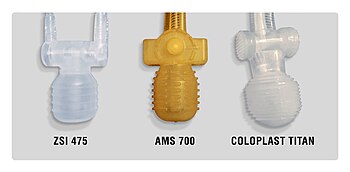Penile implant
Men's satisfaction and sexual function is influenced by discomfort over genital size, which leads some to seek surgical and non-surgical solutions for penis alteration.
[3] Willard E. Goodwin and William Wallace Scott were the first to describe the placement of synthetic penile implants using acrylic prosthesis in 1952.
[3][7][8] Small and Carrion pioneered the popularization of semi-rigid penile implants with the introduction of Small-Carrion prosthesis (Mentor, USA) in 1975.
Brantley Scott described the initial device as composed of two inflatable cylindrical bodies made up of silicone, a reservoir containing radiopaque fluid and two pumping units.
In recent years, Rigicon Innovative Urological Solutions, a US-based company, has made significant advancements in the field of penile implants.
These advancements have contributed to the diversity and progress in the development of penile implants, offering patients more varied and tailored treatment solutions.
[6] The saline solution is pumped manually from the reservoir into bilateral chambers of cylinders implanted in the shaft of the penis, which replaces the non- or minimally-functioning erectile tissue.
Since then, the IPP has undergone multiple modifications and improvements for device reliability and durability, including change in the chemical material used in implant manufacturing, using hydrophilic and antibiotic eluting coatings to reduce the rates of infections, introducing one-touch release etc.
[20] In spite of recent rapid and extensive development of non-surgical management options for erectile dysfunction, especially novel targeted medications and gene therapy, the penile implants remain the mainstay and the gold standard choice for the treatment of erectile dysfunction refractory to oral medications and injectable therapy.
[21][6] Additionally, penile implants can be a relevant option for those with erectile dysfunction who want to proceed with a permanent solution without medical therapy.
Penile implants have been used for the treatment of erectile dysfunction with various etiologies, including vascular, cavernosal, neurogenic, psychological and post-surgical (e.g. prostatectomy).
The American Urological Association recommends informing all men with erectile dysfunction about penile implants as a choice of treatment and discussing the potential outcomes with them.
[6] In Peyronie's disease, the change in penile curvature affects normal sexual intercourse as well as causing erectile dysfunction due to disruption of blood flow in the cavernous bodies of the penis.
It has been shown that implantation of inflatable penile prosthesis brings more patient and partner satisfaction than medication therapy with PDE5 inhibitors or intracavernosal injections.
[citation needed] 33% to 90% of cases of patients with Peyronie's disease that have had an inflatable PI procedure have successfully corrected their penile deformity.
It has been shown that a tissue-sparing technique, i.e. without dilation, correlates with superior outcomes – some remaining natural erectile response can be preserved, and post-operative pain is reduced as well.
[23] Other reported complications include perforation of the corpus cavernosum and urethra (0.1–3%), commonly occurring in patients with previous fibrosis, prosthesis erosion or extrusion, change in glans shape, hematoma, shortening of penis length, and device malfunction.



